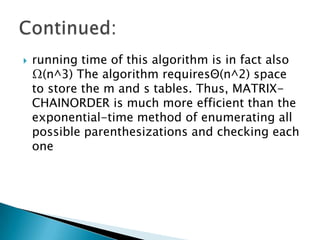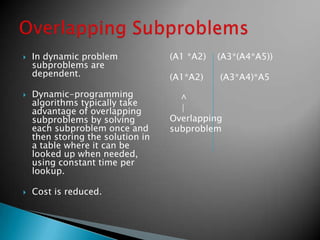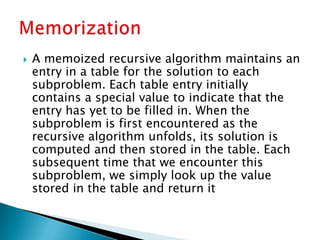The document discusses the dynamic programming approach to solving the matrix chain multiplication problem. It explains that dynamic programming breaks problems down into overlapping subproblems, solves each subproblem once, and stores the solutions in a table to avoid recomputing them. It then presents the algorithm MATRIX-CHAIN-ORDER that uses dynamic programming to solve the matrix chain multiplication problem in O(n^3) time, as opposed to a brute force approach that would take exponential time.
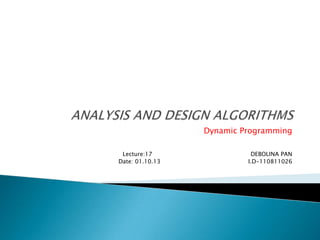
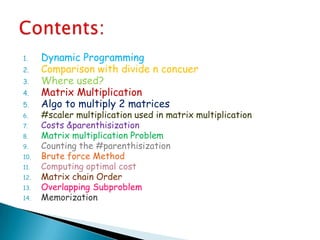
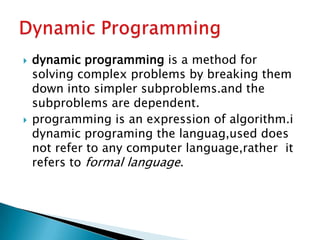
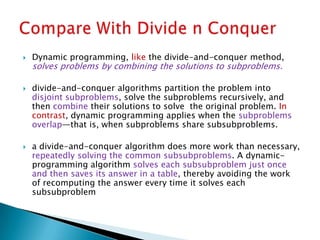
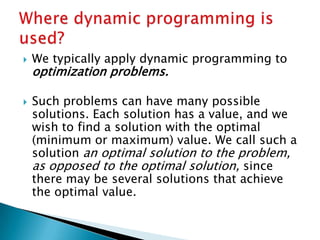
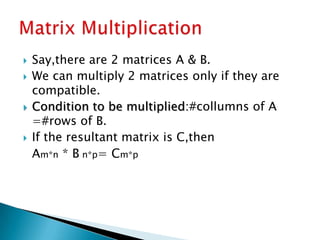
![MATRIX-MULTIPLY(A,B)
1 .if columns[A] ≠rows[B]
2 . Then error “incompatible dimensions”
3 . let C be a new A:rows B:columns matrix
4 .for i <-1 to A.rows
5 .for j<-1 to B.columns
6 .cij =0
7 .for k =1 to A.columns
8 .cij =cij + aik .bkj
9 .return C](https://image.slidesharecdn.com/dynamicprogramming1-140422091147-phpapp02/85/Dynamic-programming1-7-320.jpg)
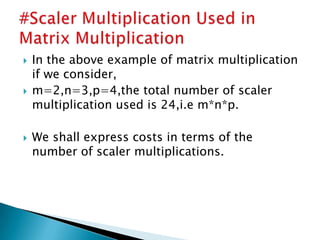
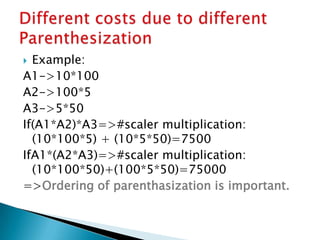
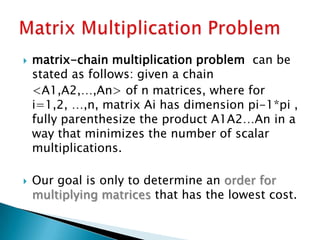

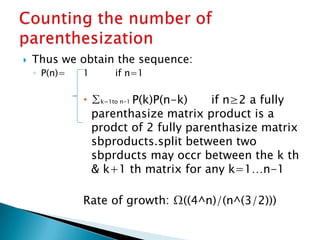
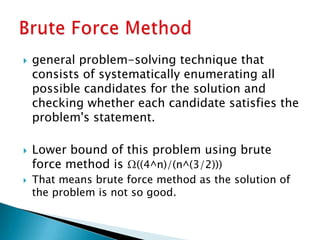
![ At this point, we could easily write a recursive
algorithm based on recurrence to compute the
minimum cost m[1,n]for multiplying A1,A2,…, An.
Aswe sawfor the rod-cutting problem, and this
recursive algorithm takes exponential time, which is
no better than the brute-force method of checking
each way of parenthesizing the product.
we have relatively few distinct subproblems: one
subproblem for each choice of i and j satisfying 1 ≤i≤
j≤n, or (nc2 +n)=Θ(n^2) in all. A recursive algorithm
may encounter each subproblem many times in
different branches of its recursion tree. This property
of overlapping subproblems is the second hallmark of
when dynamic programming applies.](https://image.slidesharecdn.com/dynamicprogramming1-140422091147-phpapp02/85/Dynamic-programming1-14-320.jpg)
![ Instead of computing the solution to recurrence
recursively, we compute the optimal cost by using a
tabular, bottom-up approach.
We shall implement the tabular, bottom-up method
in the procedure MATRIXCHAIN-ORDER, which
appears below. This procedure assumes that matrix
Ai has dimensions pi-1 *pi for i=1,2,…,n. Its input is
a sequence p=<p0; p1; : : : ;pni> where length[p] =
n+1. The procedure uses an auxiliary table
m[1…n,1…n] for storing the m[I,j] costs and another
auxiliary table s[1…n,1…n]that records which index
of k achieved the optimal cost in computing m[i; j
].We shall use the table s to construct an optimal
solution.](https://image.slidesharecdn.com/dynamicprogramming1-140422091147-phpapp02/85/Dynamic-programming1-15-320.jpg)
![ In order to implement the bottom-up approach, we
must determine which entries of the table we refer to
when computing m[i,j].the cost m[i ,j] of computing a
matrix-chain product of j-i+1matrices depends only
on the costs of computing matrix-chain products of
fewer than j-i+1 matrices. That is, for k =I,i +1,…,j-
1, the matrix Ai…k is a product of k-i+1< j-i+1
matrices and the matrix Ak+1…j is a product of j-k<
j-i +1 matrices. Thus, the algorithm should fill in the
table min a manner that corresponds to solving the
parenthesization problem on matrix chains of
increasing length. For the subproblem of optimally
parenthesizing the chain Ai,Ai+1,… Aj,we consider
the subproblem size to be the length j-i+1 of the
chain.](https://image.slidesharecdn.com/dynamicprogramming1-140422091147-phpapp02/85/Dynamic-programming1-16-320.jpg)
![MATRIX-CHAIN-ORDER.p/
1. n D p:length 1
2.Let m[1,… n.1,… n] and s[1,… n-1. 2…n] be new tables
3. for i =1 to n
4.Do m[i,j] <-0
5. for l =2 to n // l is the chain length
6. dofor i =1 to n –l+1
7. Do j<-i+l-1
8. m[i, j]<- infinity
9.for k <-i to j-1
10. Do q <-m[i, k]+m[k+1,j]+pi-1.pk.pj
11. if q <m[i,j]
12. m[i, j]<-q
13. s[i,j]<-k
14. return m and s](https://image.slidesharecdn.com/dynamicprogramming1-140422091147-phpapp02/85/Dynamic-programming1-17-320.jpg)
